
Toxic Threat: Wild Virginia Steps Up Push for PFAS Regulation
Wild Virginia is taking several actions to insist that government officials properly use their authorities to identify sources of per- and polyfluoroalkyl substances (PFAS) and prevent their release to the environment. These include:
- Advocating that Virginia acknowledge serious PFAS contamination in the Chickahominy River watershed and begin the regulatory process to inform and protect the public from exposures there and in other waterbodies, and
- Telling the Environmental Protection Agency (EPA) that it must finalize stringent criteria for the amounts of certain types of PFAS that are prohibited in our waters. (here is a letter we sent)
The Department of Environmental Quality (DEQ) Must Act Now
PFAS, commonly called “forever chemicals,” are a group of dangerous substances connected to numerous adverse health effects in humans and wildlife, and are dangerous in very small amounts. They are being found widely in Virginia and we know that once these chemicals enter our waterbodies, fish and shellfish, and our own bodies, they persist for long periods and increase with further exposures through time.
While the overall problem of PFAS has many facets and must be addressed on multiple levels, we are focusing on areas where regulators have the ability, in fact a duty, to act now—not to wait for additional information or laws. We will not accept DEQ’s resistance to taking strong action and are continuing our campaign to achieve proper regulatory measures (Preventing PFAS Pollution).
DEQ and PFAS-Impaired Waters
Fish in the Chickahominy River and White Oak Swamp are heavily contaminated with several forms of PFAS, to an extent that in some cases fish should not be eaten or consumption should be limited to small amounts. These conditions clearly violate the state water quality standards (WQS) but DEQ has so far failed to take the necessary action to protect the public.
DEQ and the Virginia Department of Health (VDH) first warned the public of these PFAS threats in December of 2022, stating in a Middle Chickahominy PFAS Study: “It is recommended that sensitive populations (e.g. children and pregnant women) avoid eating fish from the Middle Chickahominy River watershed until EPA finalizes recommendations to protect human health from exposure through fish ingestion.” More recently, VDH has officially issued a fish consumption advisory for one form of PFAS, perfluorooctane sulfonate (PFOS).
Under the Clean Water Act and state law, when a pollution problem leads to violation our state water quality standards, the DEQ is legally obligated to report those findings to the public, to EPA, and to Congress, and affected waters are to be designated as “impaired.” That impairment designation then requires a series of actions to eliminate the standards violations.
These actions are supposed to be taken through a document entitled the water quality assessment integrated report (IR), which is produced every two years and submitted by the state to EPA for its review and approval. Virginia issued a draft IR in 2024 and Wild Virginia submitted comments noting that DEQ’s own data and public statements show that heavy PFAS pollution in the Chickahominy watershed violate state WQS, which prohibit creation of conditions that are toxic or harmful to people and wildlife and interfere with beneficial uses.
In March 2025 DEQ submitted its deficient IR to EPA. Because EPA can and should disapprove DEQ’s IR and insist on proper designations, Wild Virginia began submitting to EPA and arguing that the agency must officially object to Virginia’s impaired waterbodies list, because that list didn’t include the necessary impairment listing. As of May 19, EPA had still not made a decision about Virginia’s IR. We will continue to monitor both agencies’ actions and let you know the results.
EPA and Virginia Must Adopt Protective PFAS Criteria for Waterbodies
One tool to effectively control PFAS releases through regulatory actions is numeric water quality criteria¾specific concentrations that must not be exceeded in streams, wetlands, and the Chesapeake Bay. The criteria are an important supplement to the narrative criteria already included in Virginia regulations and enforceable by DEQ.
Wild Virginia submitted comments to EPA in April supporting the issuance of recommended numeric criteria for three forms of PFAS. We strongly urged EPA to finalize those recommendations that were advertised for comment in December, 2024 and we noted that:
Very stringent criteria are important for all of the three named substances but they are especially vital in relation to PFOA and PFOS, given that these compounds are deemed by EPA to be “likely” carcinogens. There is a decades-long consensus among scientists that there is no safe level of a carcinogen, so the goal in establishing safety measures, such as these criteria, should be to prevent detectable levels of these substances wherever possible.
Again, we await a decision by the federal agency about these criteria. It is important to note though that Virginia has an independent obligation to adopt appropriate numeric criteria, even in the absence of final recommendations by EPA. This separate state authority is more important now that the federal government threatens to weaken or eliminate pollution control rules.
Wild Virginia has volunteered to serve on a regulatory advisory panel for upcoming reviews of state WQS and will insist that the State Water Control Board adopt criteria that reflect analyses by EPA and other scientists that much compel the development of very restrictive limits on PFAS in our waters. It is notable that data reported by DEQ shows that some of our streams exceed target levels cited by EPA by tens of thousands of times.
Action by the State of Virginia to protect us and our ecosystems from PFAS must happen NOW! Wild Virginia is fighting every day, in all available avenues to push for that action. As always, we need and appreciate your support.